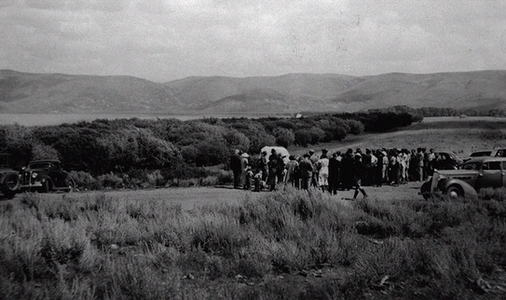BEAR LAKE

Trappers' Rendezvous site, Bear Lake
Bear Lake is located on the Idaho-Utah border, only twenty miles from Wyoming. It is thirty miles long and eight miles wide, has depths of over two hundred feet, and is nearly 5,900 feet in elevation. The lake is renowned for its beautiful turquoise color and its attractiveness to tourists.
The lake was known to numerous Native American groups who came into the Bear Lake Valley during the summers, and from them it received its name. French-Canadian trappers working for the Hudson Bay Company followed the Bear River upstream and recorded views of the lake as early as 1818. American trappers held two successive rendezvous on the lake's south shore in the late 1820s. Included among those fur traders were Jedediah Smith and Jim Bridger. From the trappers, Bear Lake received a well-deserved reputation for harsh winters.
During the period from 1836 to the 1850s many Oregon-bound pioneers followed the Oregon Trail, which ran north and east of the lake, but none went sightseeing to the south. In 1863, Mormon pioneers led by Charles C. Rich moved permanently into the Bear Lake Valley, but their original agreement with Native Americans left most of the Utah portion of the valley in Indian hands. Gradually, the Mormons moved south and the villages of Garden City, Pickleville, and Laketown, all near the shore, came into being.
Bear Lake became a resort and recreation area, and that aspect has grown through the years with developers attempting to sell lakeshore and mountain view lots. Lakota and Ideal Beach gave way in the 1970s to private developments such as Blue Water and Sweetwater. The State of Utah purchased the far southeast beach as a state park and also operates a marina on the west side. Summer recreational activities abound as sailing, waterskiing, and boating attract thousands to the lake. Bear Lake is also noted for its surrounding natural habitat and the production of succulent red raspberries, as well as cisco and lake trout from within the lake itself.
The development of Bear Lake has led to natural environmental concerns. The magnificent body of water is diked on the Idaho side so that downstream Bear River water users see it as another reservoir. This multifaceted lake faces a precarious future as the demand for water increases. It is literally a jewel of the high mountain valleys and deserving of our care and protection.
Disclaimer: Information on this site was converted from a hard cover book published by University of Utah Press in 1994. Any errors should be directed towards the University of Utah Press.